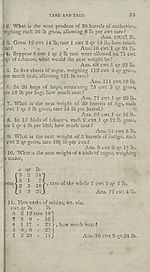Download files
Complete book:
Individual page:
Thumbnail gallery: Grid view | List view

[ 54 ]
TARE AND TRET.
Gross weight of any commodity is its own weight,
gether with that of its package, whether it be cask, chej
or any thing else.
Tare is the weight of the package, or an allowan
made instead of it.—What remains after the tare is tak
from the gross, may be called tare-suttle, if there be me
deductions.
Tret is an allowance of 4 lb upon every 104 lb of
suttle, on account of dust or Other waste.—What rema
after tret is deducted, may be called tret-suttle, if there
any following deduction.
Cloff is an allowance of 1 lb for every 3 cwt, and soi
say for every 100 lb of tret-suttle, to make tire weight h«
good when sold by retail.
When all the deductions are made, the last remaindei
called neat, or net weight.
Note 1. When the tare is at so much per ,cwt, It will he best to
vide it into aliquot parts of it, like as in the Rule of Practice.
2. The tret being 4 to 104, or 1 to 26, will be found by taking
£6th part of the tare-suttle.
2. in calculating oil and spirits, ’i\ lb neat are allowed to the gall
Examples.
1. Gross 17 cwt 3 qr 14 lb, tare 12 lb per cwt, tret
104, and cloff 2 to 100, or 1 to 50. How much neat i
qr lb
17 3 14 gross
8 — Aj
4 = 5
1
1 3
2 154
1 3 184 tare
15 3 234 tare-suttle
0 2 124 tret
1 104 tret-suttle '
0 1 6J cloff
15 0 44 net
TARE AND TRET.
Gross weight of any commodity is its own weight,
gether with that of its package, whether it be cask, chej
or any thing else.
Tare is the weight of the package, or an allowan
made instead of it.—What remains after the tare is tak
from the gross, may be called tare-suttle, if there be me
deductions.
Tret is an allowance of 4 lb upon every 104 lb of
suttle, on account of dust or Other waste.—What rema
after tret is deducted, may be called tret-suttle, if there
any following deduction.
Cloff is an allowance of 1 lb for every 3 cwt, and soi
say for every 100 lb of tret-suttle, to make tire weight h«
good when sold by retail.
When all the deductions are made, the last remaindei
called neat, or net weight.
Note 1. When the tare is at so much per ,cwt, It will he best to
vide it into aliquot parts of it, like as in the Rule of Practice.
2. The tret being 4 to 104, or 1 to 26, will be found by taking
£6th part of the tare-suttle.
2. in calculating oil and spirits, ’i\ lb neat are allowed to the gall
Examples.
1. Gross 17 cwt 3 qr 14 lb, tare 12 lb per cwt, tret
104, and cloff 2 to 100, or 1 to 50. How much neat i
qr lb
17 3 14 gross
8 — Aj
4 = 5
1
1 3
2 154
1 3 184 tare
15 3 234 tare-suttle
0 2 124 tret
1 104 tret-suttle '
0 1 6J cloff
15 0 44 net
Set display mode to:
![]() Universal Viewer |
Universal Viewer | ![]() Mirador |
Large image | Transcription
Mirador |
Large image | Transcription
| Antiquarian books of Scotland > Education > Complete treatise on practical arithmetic and book-keeping > (68) |
|---|
| Permanent URL | https://digital.nls.uk/114434386 |
|---|
| Description | Thousands of printed books from the Antiquarian Books of Scotland collection which dates from 1641 to the 1980s. The collection consists of 14,800 books which were published in Scotland or have a Scottish connection, e.g. through the author, printer or owner. Subjects covered include sport, education, diseases, adventure, occupations, Jacobites, politics and religion. Among the 29 languages represented are English, Gaelic, Italian, French, Russian and Swedish. |
|---|

